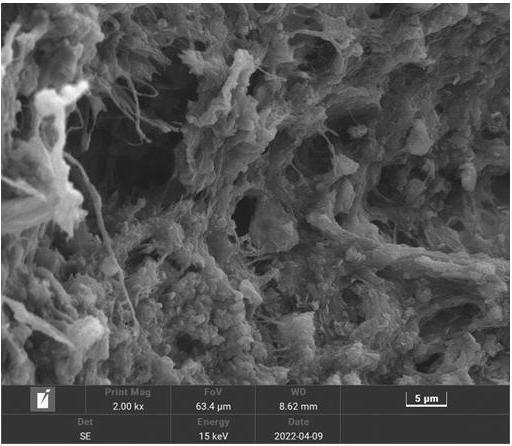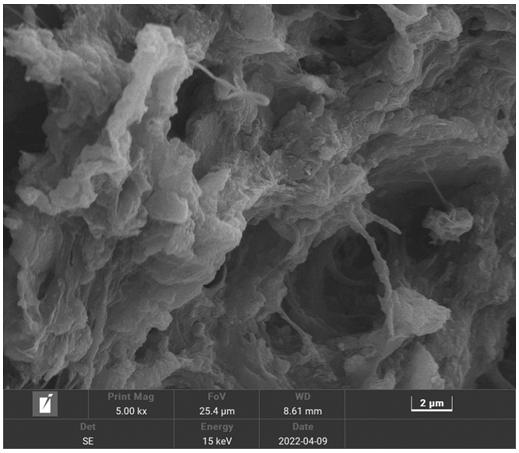Curing process for municipal dewatered sludge
A technology of dewatering sludge and solidification process, which is applied in water/sludge/sewage treatment, sludge treatment, chemical instruments and methods, etc. It can solve the problems of increasing landfill volume, adding more curing agent, and occupying a large area. problem, to achieve the effect of less curing agent dosage, good curing effect and small volume expansion
- Summary
- Abstract
- Description
- Claims
- Application Information
AI Technical Summary
Problems solved by technology
Method used
Image
Examples
Embodiment 1
[0030] (1) First put 1.6kg of wet sludge (80% moisture content) into the stirring pot and stir it evenly;
[0031] (2) Prepare a certain quality of cellulase, lipase, and protease, mix them with equal quality, and weigh 3% of the composite enzyme according to the weight of the wet sludge;
[0032] (3) Prepare the complexing agent citric acid granules, and weigh 0.5% of citric acid according to the weight of the wet sludge;
[0033] (4) Mix the compound enzyme in (2) and the citric acid in (3) evenly;
[0034] (5) Put the mixture of (4) into the sludge of (1) through the funnel, stir once automatically, then slowly stir for 5 minutes, and stir quickly for 5 minutes;
[0035] (6) Put the agitated sludge in (5) into a conical flask, at 40°C, 200r·min -1 Oscillation treatment for 120h;
[0036] (7) After the enzymatic hydrolysis is completed, take out the sludge in (6), weigh out the sludge mass, and put it into the stirring pot to stir evenly;
[0037] (8) Weigh 3% potassium ...
Embodiment 2
[0047] (1) First put 1.6kg of wet sludge (80% moisture content) into the stirring pot and stir it evenly;
[0048] (2) Prepare a certain quality of cellulase, lipase, and protease, mix them with equal quality, and weigh 3% of the composite enzyme according to the weight of the wet sludge;
[0049] (3) Prepare the complexing agent citric acid granules, and weigh 0.5% citric acid according to the weight of the wet sludge;
[0050] (4) Mix the compound enzyme in (2) and the citric acid in (3) evenly;
[0051] (5) Put the mixture of (4) into the sludge of (1) through the funnel, stir once automatically, stir slowly for 5 minutes, and stir quickly for 5 minutes;
[0052] (6) Put the agitated sludge in (5) into a conical flask, at 40°C, 200r·min -1 Oscillation treatment for 120h;
[0053](7) After the enzymatic hydrolysis is completed, take out the sludge in (6), weigh out the sludge mass, and put it into the stirring pot to stir evenly;
[0054] (8) Weigh 4% potassium ferrate p...
Embodiment 3
[0063] (1) First put 1.6kg of wet sludge (80% moisture content) into the stirring pot and stir it evenly;
[0064] (2) Prepare a certain quality of cellulase, lipase, and protease, mix them with equal quality, and weigh 3% of the composite enzyme according to the weight of the wet sludge;
[0065] (3) Prepare the complexing agent citric acid granules, and weigh 1% of citric acid according to the weight of the wet sludge;
[0066] (4) Mix the compound enzyme in (2) and the citric acid in (3) evenly;
[0067] (5) Put the mixture of (4) into the sludge of (1) through the funnel, stir once automatically, then slowly stir for 5 minutes, and stir quickly for 5 minutes;
[0068] (6) Put the agitated sludge in (5) into a conical flask, at 40°C, 200r·min -1 Oscillation treatment for 120h;
[0069] (7) After the enzymatic hydrolysis is completed, take out the sludge in (6), weigh out the sludge mass, and put it into the stirring pot to stir evenly;
[0070] (8) Weigh 3% potassium fe...
PUM
| Property | Measurement | Unit |
|---|---|---|
| compressive strength | aaaaa | aaaaa |
| compressive strength | aaaaa | aaaaa |
| compressive strength | aaaaa | aaaaa |
Abstract
Description
Claims
Application Information
 Login to View More
Login to View More - R&D Engineer
- R&D Manager
- IP Professional
- Industry Leading Data Capabilities
- Powerful AI technology
- Patent DNA Extraction
Browse by: Latest US Patents, China's latest patents, Technical Efficacy Thesaurus, Application Domain, Technology Topic, Popular Technical Reports.
© 2024 PatSnap. All rights reserved.Legal|Privacy policy|Modern Slavery Act Transparency Statement|Sitemap|About US| Contact US: help@patsnap.com










